The second life of BRDM. Scouts on "civilian." Part two
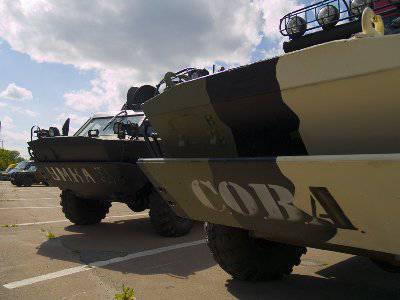 Dear readers! This is the second part of the review on the civilian versions of the BRDM-2. The first part is here: The second life of BRDM. Scouts on "civilian." Part one.
Dear readers! This is the second part of the review on the civilian versions of the BRDM-2. The first part is here: The second life of BRDM. Scouts on "civilian." Part one. Dream dressed in armor
Oleg Makarov. Gunsmith store network "Barrel", Kiev.
Oleg Makarov from Kiev has always dreamed of a machine that can rush along the road or without it, cross ragged fields diagonally, ride along the river or across, climb in search of adventure to places where an ordinary SUV sits down on the most tinted windows. In order not to be an elm in a meter snowdrift, he effortlessly jumped a trench 1,2 meter wide and did not fear the 30-degree rise. But why reinvent the wheel when the BRDM exists?
Oleg’s perseverance, like fanaticism, was finally rewarded, and he found the cars in perfect condition.
After passing through numerous bureaucratic procedures and approvals in various departments, they received a “self-propelled vehicle based on the BRDM-2” (this is written in the data sheet), or more simply, a tractor in Kiev’s numbers, which is allowed to move everywhere except for places that prohibit the movement of tractors. In Kiev it is historical city center.
Then the fun began. The whole family was connected to the process of creating a super-SUV, and by joint efforts two models of cars were born, the main concept of which is a comfortable rest outside of civilization.
BRDM is a platform for unlimited creative tuning for every taste. The creation of cars took nine months, which in itself is very symbolic. During this period, experience and a team of like-minded people appeared - as a result, two such different SUVs were born. What was considered a hobby at the very beginning of the project has now grown into a small-scale issue for people keen on hunting and fishing. Those who are too small size hunting jeep and boats.
Now (December 14 2009) in the work of several machines, in the construction of which taken proven and run-in on the projects “U.M.KA.A.” and “S.O.V.A.” technical solutions.
Price varies depending on the configuration from 50 to 80 thousands of dollars.
First car: U.M.K.A. - universal mobile amphibious camper. U.M.K.A. was designed as an off-road camper (caravan), designed for long-distance expeditions of hunters, fishermen, lovers of extreme and family holidays in isolation from civilization.
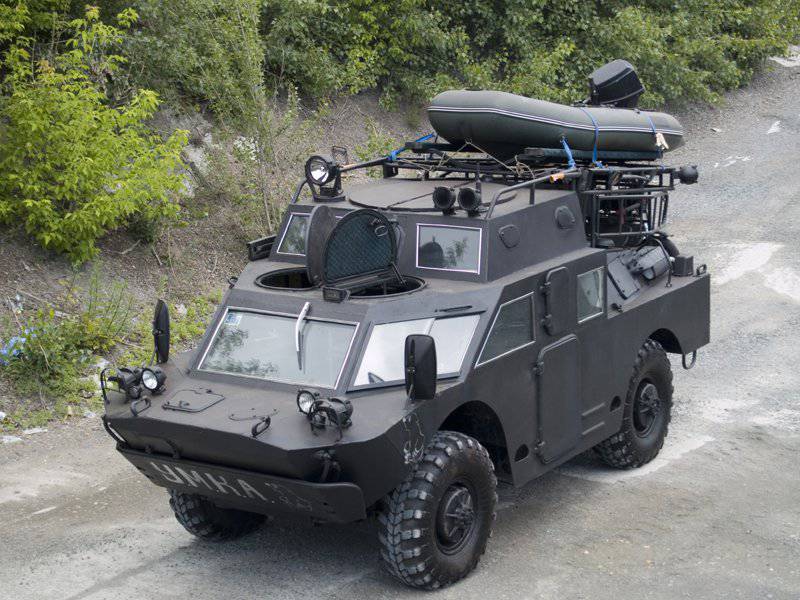
This is a real self-propelled yacht, which can go to any coast anywhere. Upstairs equipped with a full deck, and a continuous frontal armored glass gives an excellent overview from the driver's seat. Armor doors and hatches were embedded on the sides, and their locking knots were refined with valves, like on a submarine. To increase the internal space of the crew compartment, the roof was raised by 500 mm. In the spacious and bright cabin on the sides facing each other, two leather seats. In the center is a square table-book, folding in three positions. The first main position is the table. Raising it to the second position, we decompose the left and right parts - the bunk beds are ready. In this case, the lower tier is the raised part of the cabin, under which the lockers are located. In the extreme upper position, we get a platform for shooting and viewing through the upper hatches.
Above the engine compartment fixed wooden sliding cabinets, equipped with everything necessary for cooking.
Opening them in different directions, we get access to an additional external trunk with a volume of 1,5 cube. m. You can also get there through the hatch outside the camper.
The built-in retractable arms cabinet, lined with cork, allows you to place four carbines and ammunition. The salon is designed for the comfortable movement of four hunters in winter clothes and weapons. Full load - 6-8 people, not counting the driver and navigator.
U.M.K.A. (explanation by Oleg Makarov).
The upper module is removable: either a boat (up to 4 meters), or a 2 two-axle quad bike across, or a three-axis 1 lengthwise. As options - snowmobiles, jet skis. The top module is removed / placed on the water / ground using a folding davit with a 3 ton winch (starboard). Rear module - motorcycle. The most important! Ride for vodka or gasoline ...
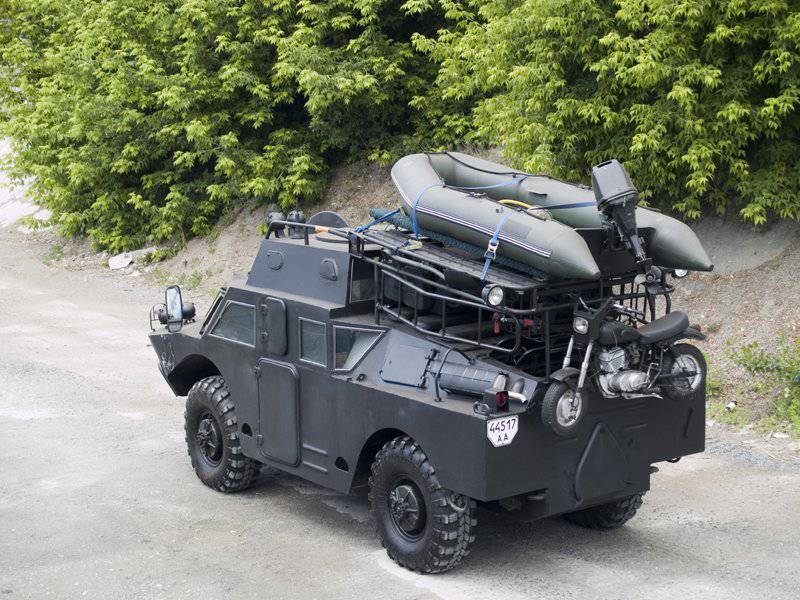
[Center]
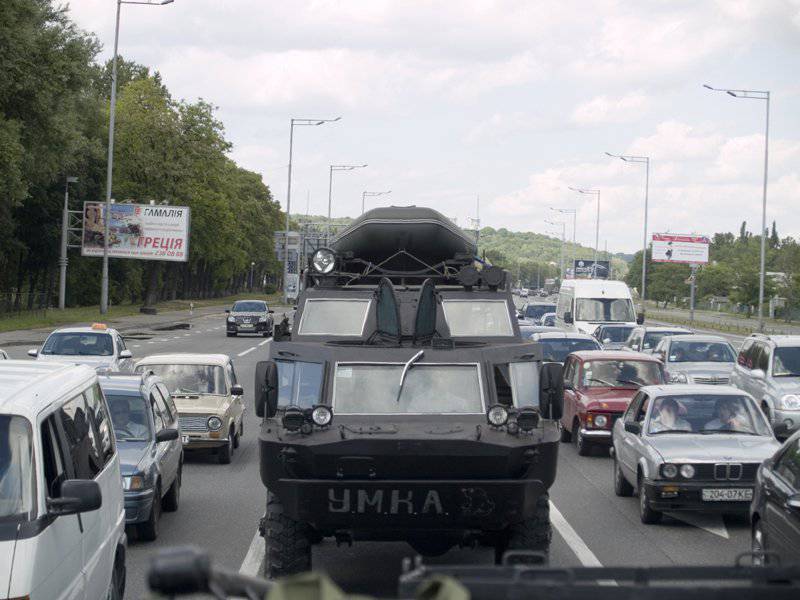
Are swimming The original BRDM-2 has positive buoyancy, due to the double bottom and sealed feed compartments / tanks. In the UMKE, due to raising the roof of the hull and increasing the internal volume of the cabin, the windage increased, which slightly affected the maneuverability on land.
On the other hand, it is a big plus on the water. The seaworthiness increased and a full-fledged upper deck appeared, on which you do not need to wipe your face from the splashes that fly over you while the jet engine is working and the feeling of staying on a yacht penetrates deeper into the body in the sun.
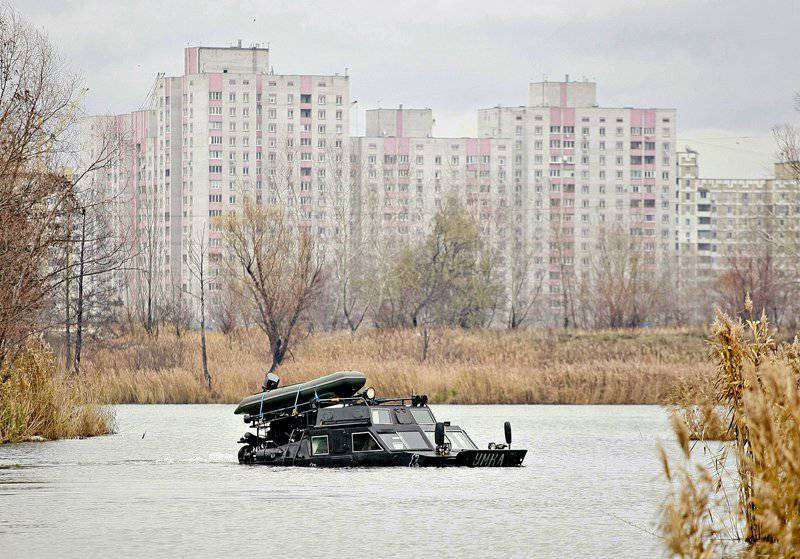
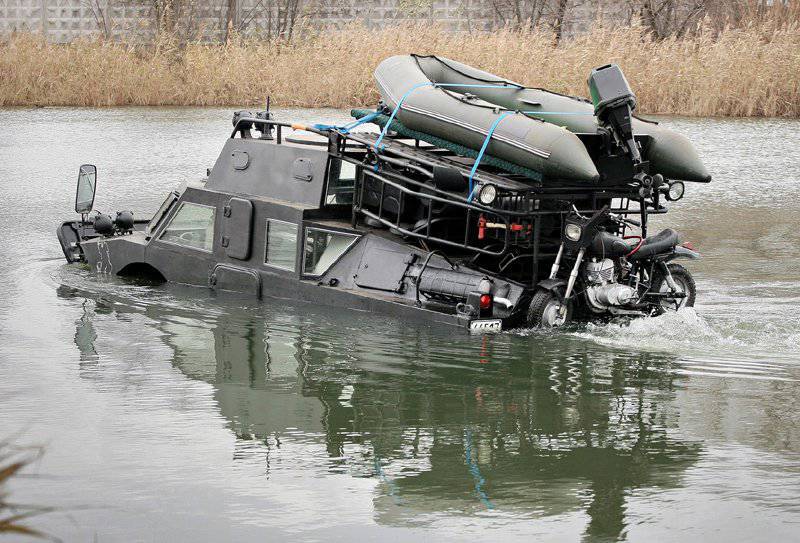
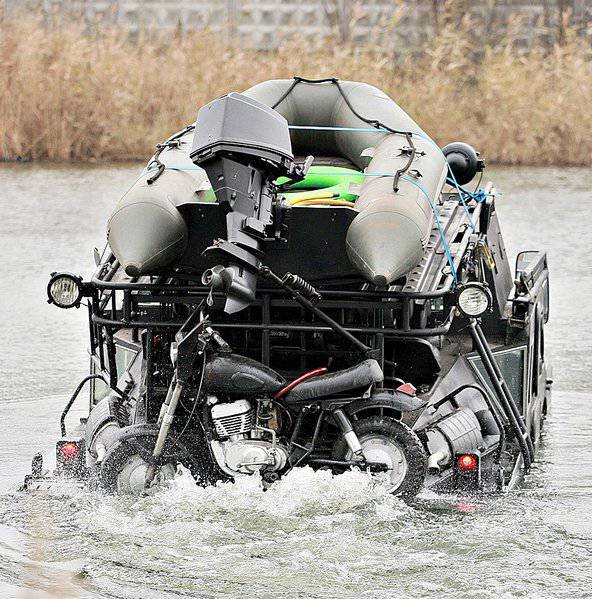
The original BRDM on the water is almost imperceptible - for the sake of masking on the water, and our U.M.K.A has improved its nautical qualities at times. A little visually angular on land, on the water it looks like a full-fledged motor yacht. Armored boat - for sure!
We are swimming at the expense of the water jet. They put water sensors in the cabin and automatic pumps from the "burzhuinsky" boats. Native manual switching is also left, but changed to a more powerful one with an armored troop-carrier. On the problem (shaky) beach we leave, throwing off the tire pressure.
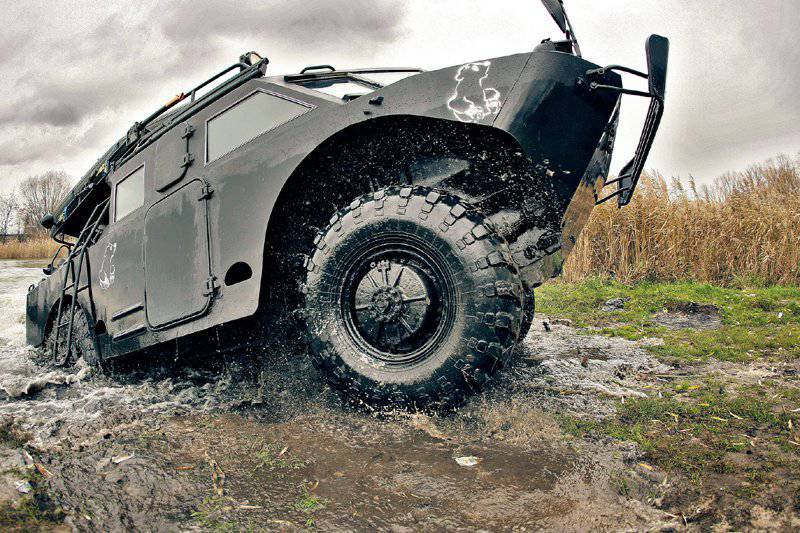
We accelerate to the maximum in the water, turn on both bridges and lower bridges - and the car just jumps onto the steep bank!
The car body. It is completely sheathed inside with various finishing materials on the sandwich principle. We paid special attention to the inner lining of the machine body, as in the primary version it is a tin can of armor metal. To begin with, we processed the entire inside of the machine with American liquid insulating ceramics (up to 500 degrees C), which completely excluded the possibility of heating. Then, in layers, with the help of special tools and technologies, isoplain, isolon (for noise, vibration insulation) and the final, finishing layer, which in turn is also protective, were laid.
Depending on the internal location of the finishing layer, corrugated aluminum, rubber-based carpet, natural cork or leatherette with imitation of reptile skin were used. Thus, the noise and vibration in the cabin disappeared, and the effect of a thermos made it possible to maintain a comfortable cabin temperature. In summer, the peak of heat (over 35 degrees) in the car without even turning on the air conditioner is quite comfortable.
The original armored car in such heat is a sheer gas chamber: half an hour inside the BRDM, and heatstroke is guaranteed to the pampered city dweller. As a result of sound insulation in the conveyor U.M.K.A. you can talk normally while driving without tank headsets, as in the BRDM. And you don’t worry about breaking your forehead against the armor!
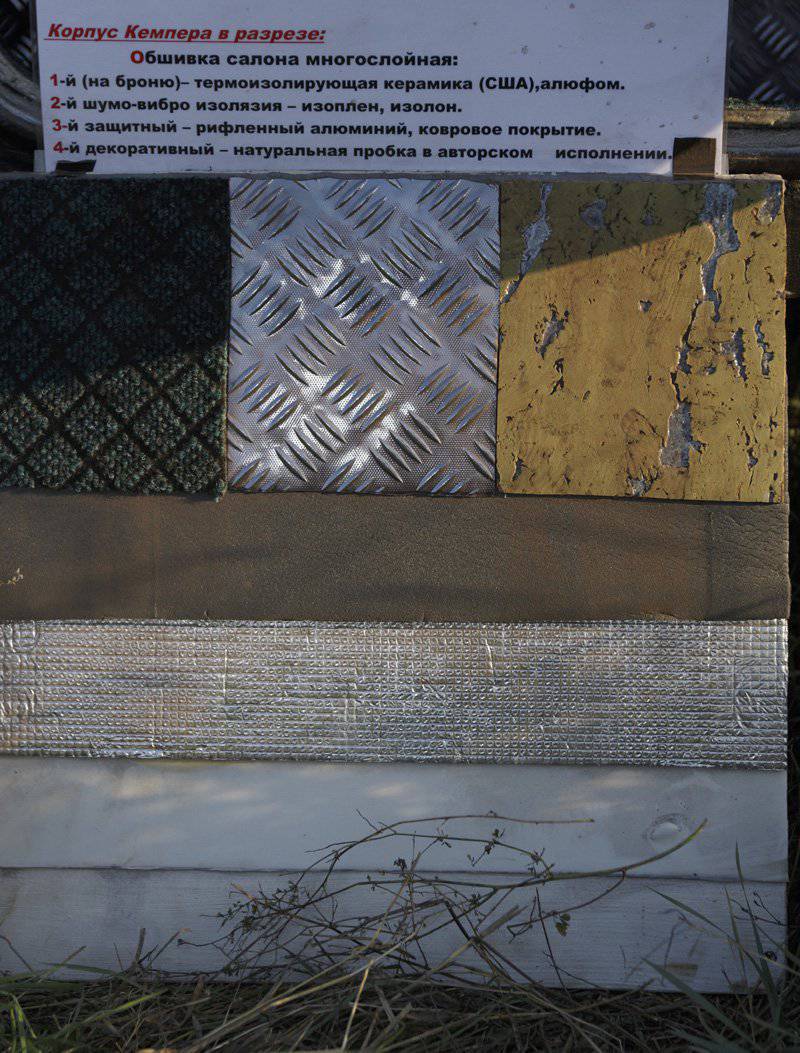
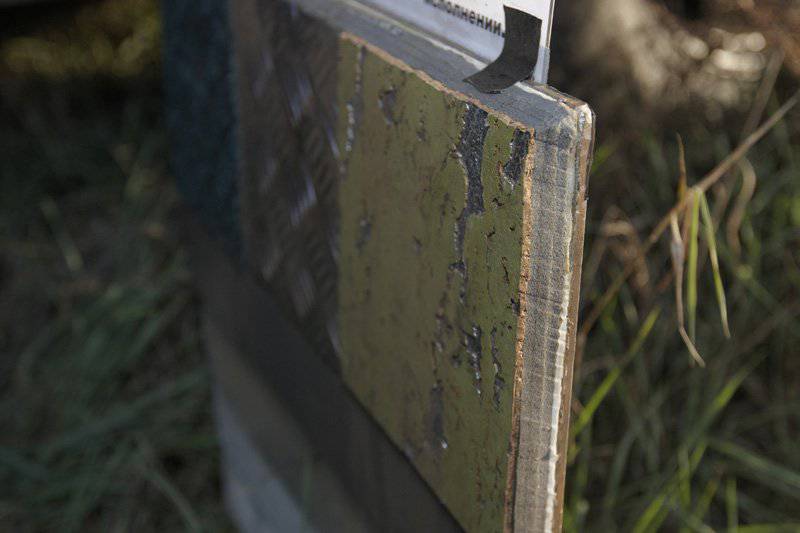
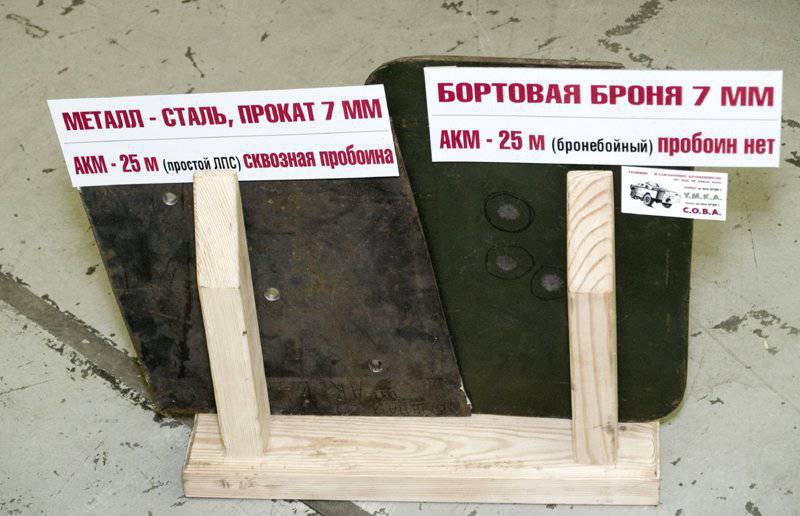
GlassFront armored glass 60 mm thick "holds" a shot from SVD and PKM with 50 meters. Lateral - 20-40 mm, and "hold" a shot from the SVD and RMB with 50 meters. Side - 20-40 mm, and "hold" a shot from the AKM at close range. Glasses were the main element of preserving the native ideal weight distribution on the axis: 50 on 50. The whole package of bulletproof glass is very heavy: how much metal was welded on the stern (trunk, etc.), so much bulletproof glass was added to the nose and center. Weighing 50 to 50 on the axis is very important for any "right" jeep, and for a floating one - even more so. Also, bulletproof glass serve as protection when working with a winch (it is controlled from the cabin). In the original BRDM, when working with a winch, armored shutters should be lowered onto the windows. This is done so that the torn cable does not cut the crew in half. We have increased the protection level of the crew with bulletproof glass with a thickness of 60 mm.
Well and, seriously, what glasses, if not armored, should be on the armored car? Side armored glass made sliding, while maintaining tightness from the oncoming wave.
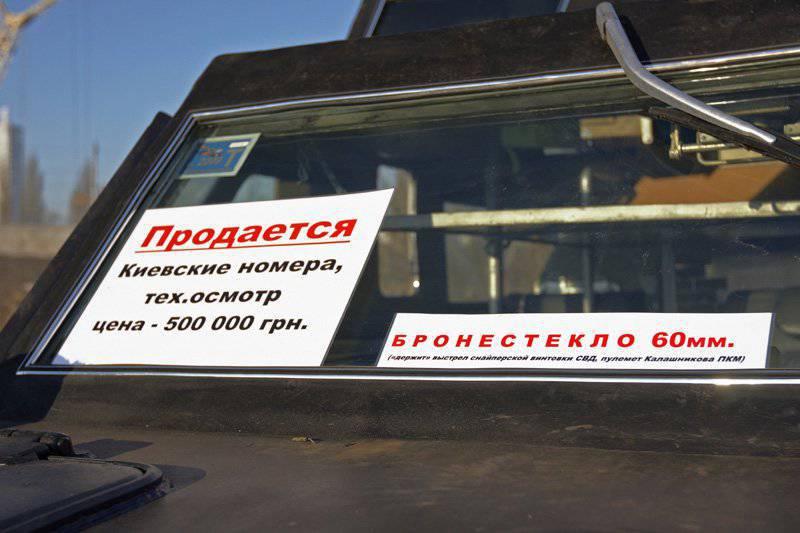
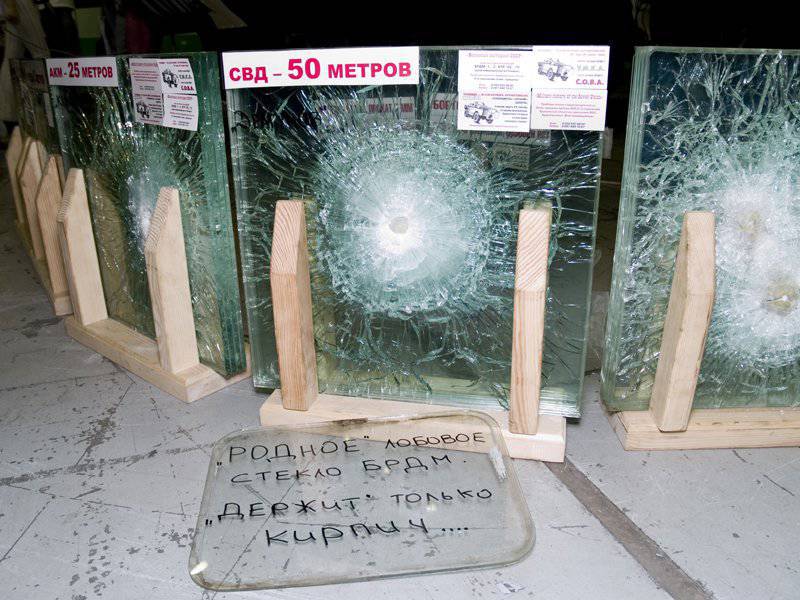
Cabin. The original BRDM-2 is good for everyone - an SUV of all times and peoples ... The terrain is monstrous: the forest can be felled. But driver comfort was not among the tasks assigned to the designers. The more I do tuning armored cars, the more I become convinced that the driver of the original BRDM is a man of one and a half meters in height, with six hands, like that of the Indian deity Shiva.
As for growth, it is understandable - you can split your forehead on armor. And about the hands I will explain: the controls are made almost around the driver's seat. We moved all the traction and leverage to an intuitively comfortable place under the left arm. And they also changed the angle of inclination of the frontal armor plate and increased it in height. Now the limit on growth in the 2,05 meter, and leverage is easy and convenient to manage.
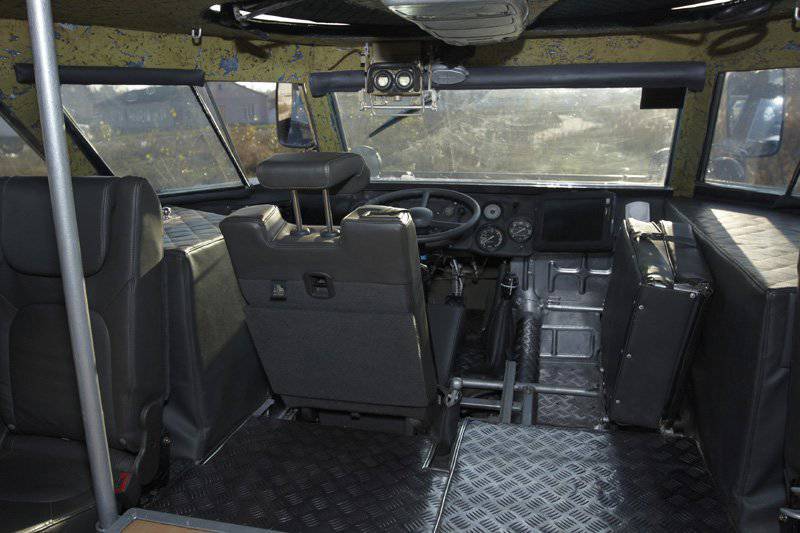
Changed the cabin ideology: the place on the right (commander) is now a multifunctional navigator-chasseur post. Sidushka there three-position. The first position is strapped to starboard. This is a convenient passage for the driver to his place (still better than the old-fashioned way through the hatch from above). The second position - the seat is folded back down. This is a table for the driver. The third is basic. Navigator-Jaeger seat.
In front of it are a winch control unit, a Hammerhead-based navigation panel with a shock-resistant computer, echo sounder, GPS, night vision devices, external light control and an electronics control unit operating on 220 volts (using an 3 automotive car voltage inverter, onboard 24 are converted to 220).
The camper is equipped with: refrigerator, microwave, coffee maker, power plant, audio, video system.
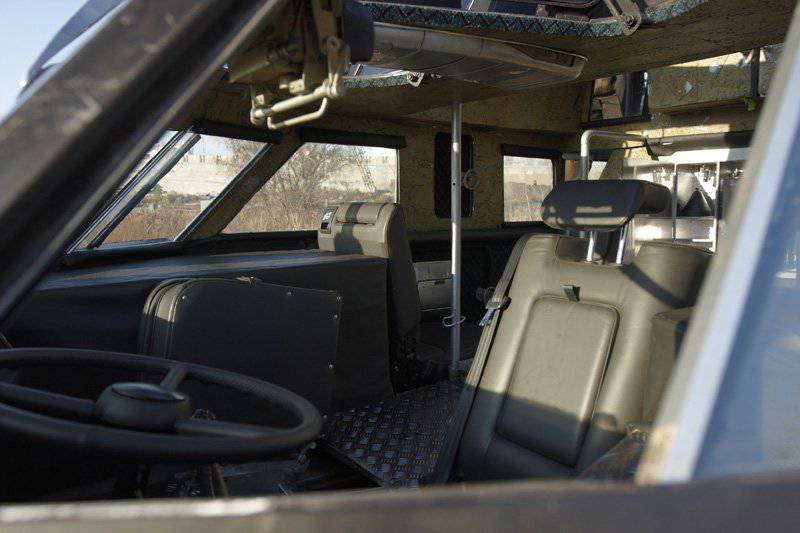
The control of external lighting devices is also duplicated by the driver. Between the driver and the navigator, on the ceiling, in an aircraft-mounted panel from the Toyota Land Cruiser 100. There are "glove boxes" and control of the light in the cabin. The driver's seat, like all the other leather seats, are the seats taken from the Nissan Pathfinder. Upgraded to the new options dashboard obtyanuli skin. The second (new) full instrument panel is to the left of the driver. The old Soviet toggle switches and levers on the panel were changed to modern ones, with backlighting and additional fixation.
Salon. In the spacious and bright cabin of the camper on the right and left side facing each other are located on the 2 leather seats, borrowed from the Nissan Pathfinder II. A similar chair is located on the seat of the driver and navigator (folding). Between the 4 vertical handrail pipes running from the base to the ceiling in the very center of the cabin, there is a square transforming book table that has 3 positions. The first main position is the table. Climbing the pipe-guiding table to the second position, lay the left and right sides, fix the table tops with the help of clips and get the second tier of the bed.
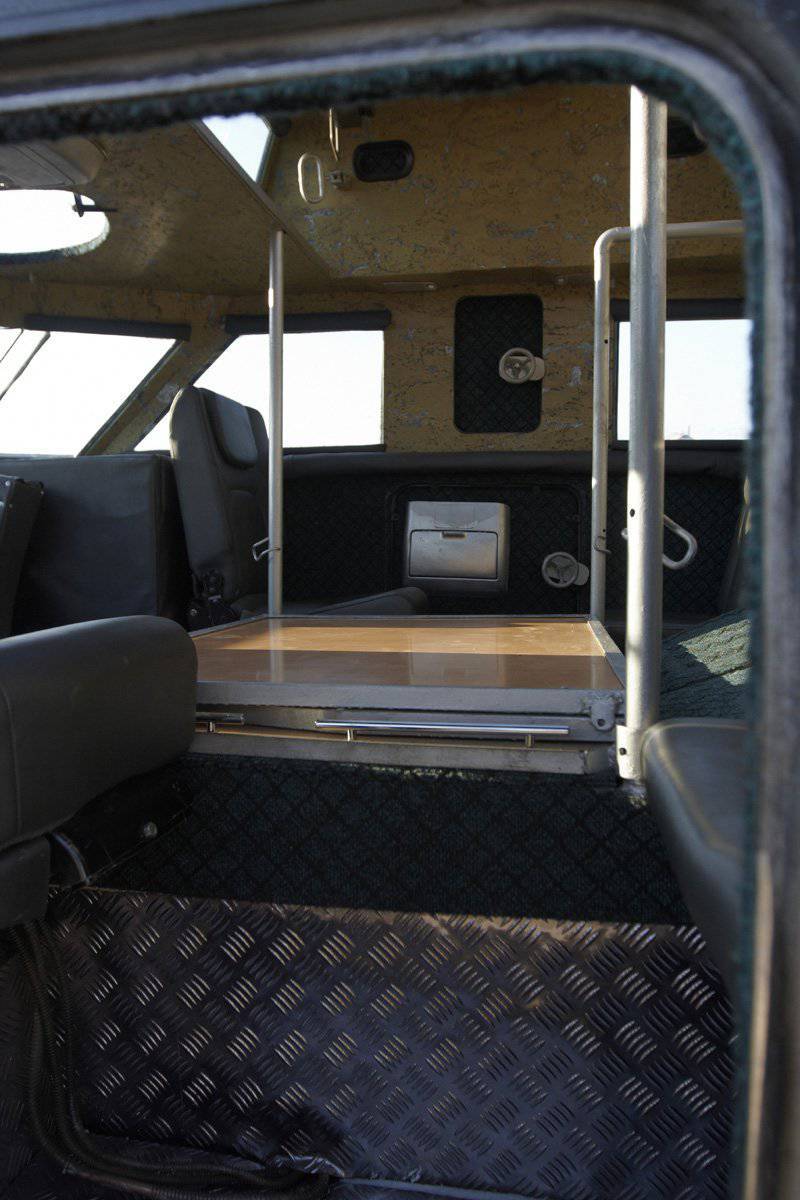
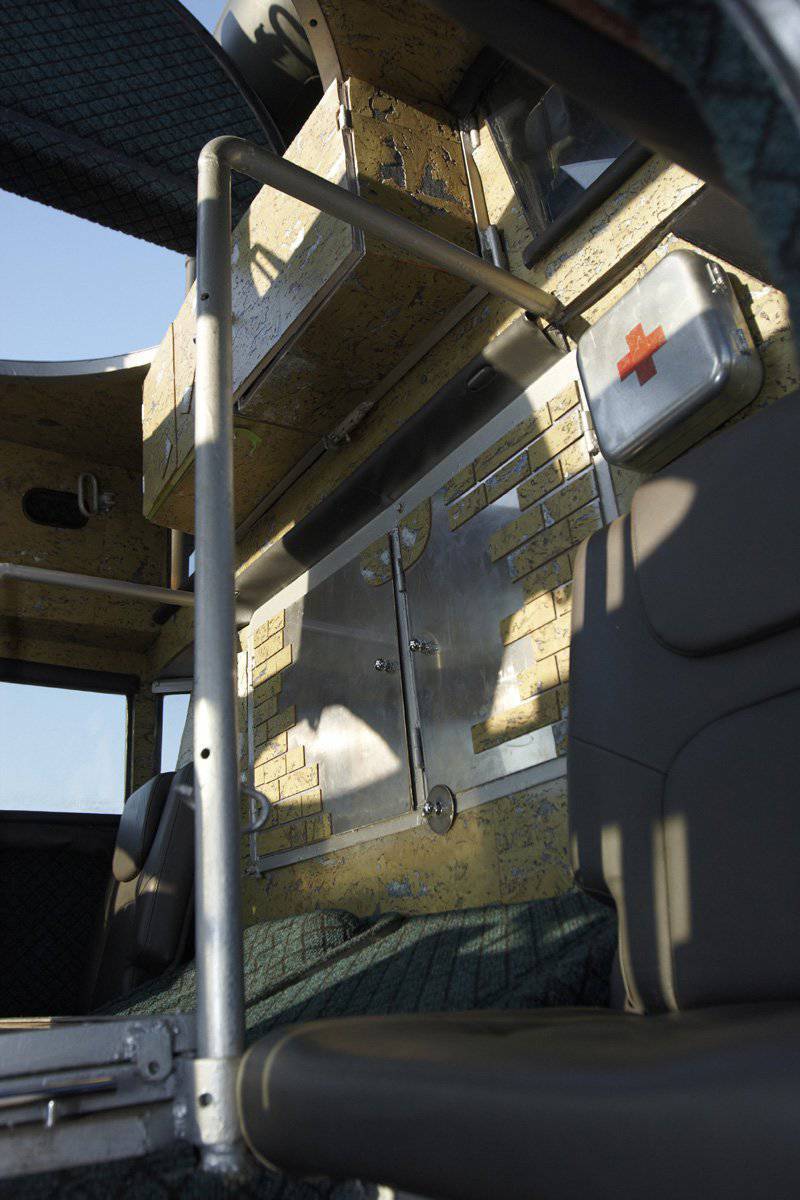
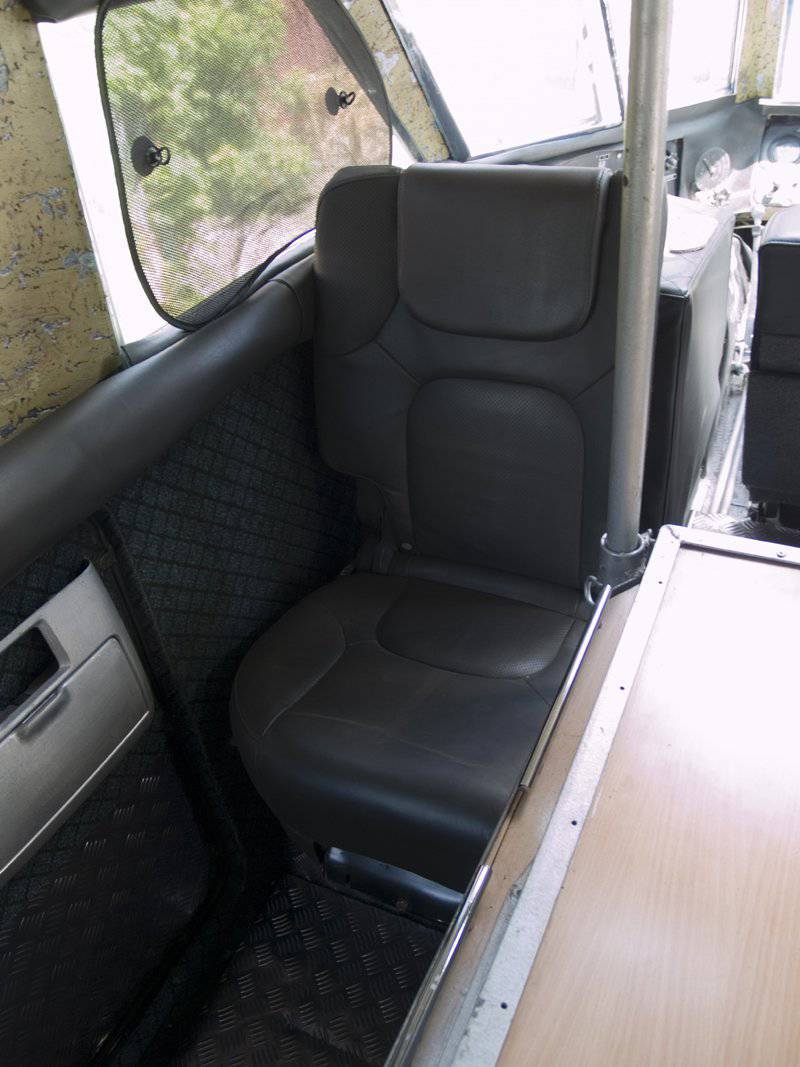
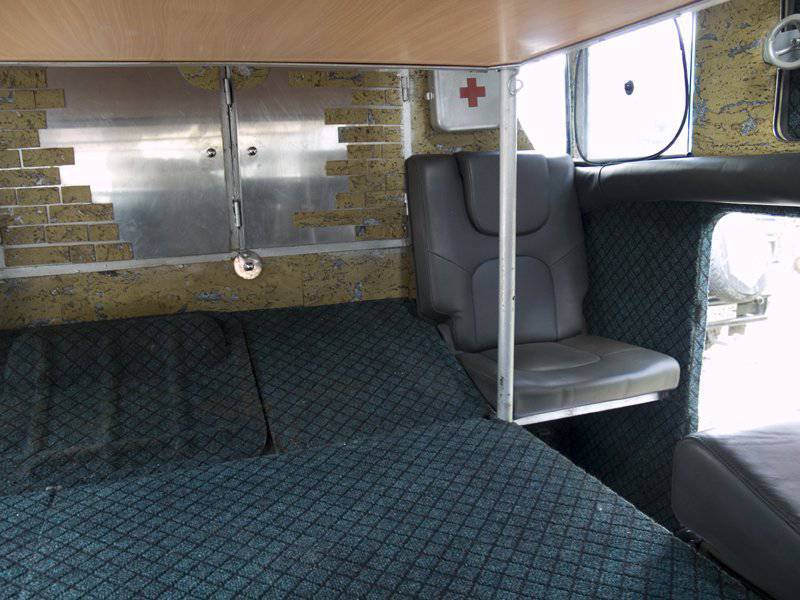
In this case, the first tier of the bed is the central raised part of the cabin, under which the lockers (drawers) are located. The length of the lower tier of the bed is 250 cm, and the top one is 200 cm with a total width of 150 cm. Lifting the pipes along the guide table to the upper, third position, we get a platform for shooting and observation through the camper's upper hatches. When fixing in the upper, third position, we get access to the floor lockers and transmission hatch located under them. Above the engine compartment are fixed wooden sliding cabinets (lockers) equipped with kitchen and picnic accessories.
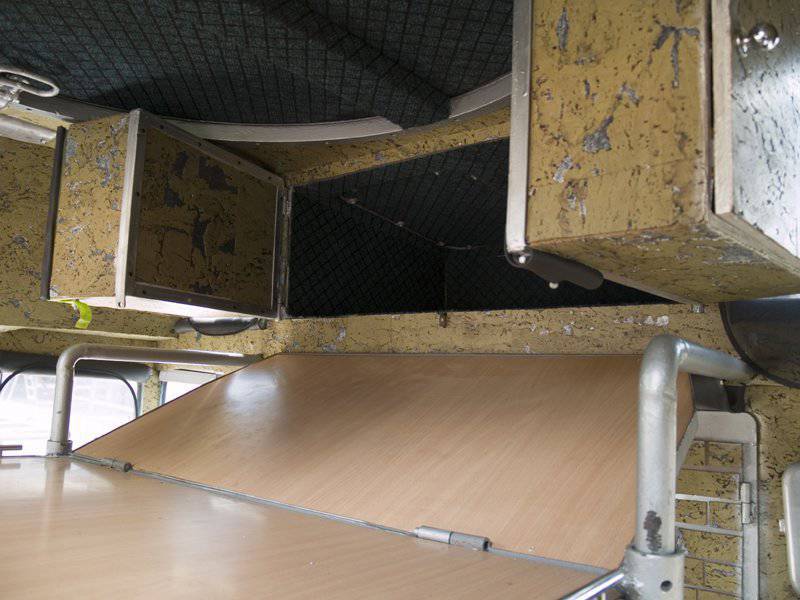
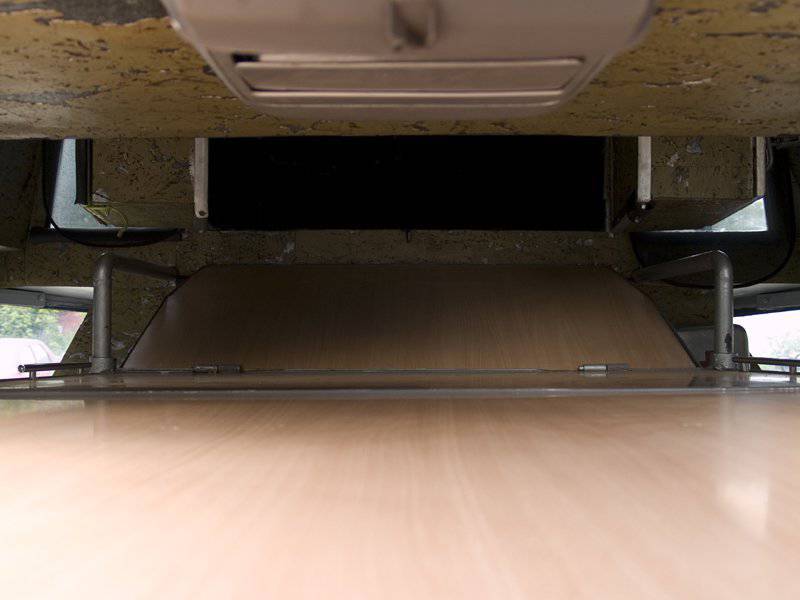
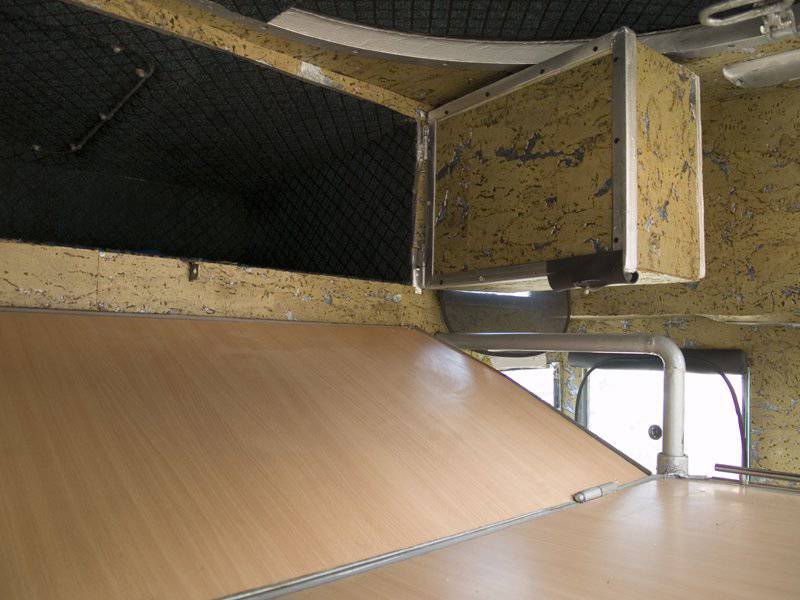
Cabinets (lockers) are removable, attached to the hinges welded to the interior of the cabin. Opening them in different directions, we get access to an additional (hidden) trunk from the passenger compartment, which can be used as a fridge for game (1,5 square meters in volume). Access to the trunk-fridge can also be obtained through the external hatch, outside the camper.
The built-in sliding weapon cabinet is corked and allows the 4 carbine and ammunition to be positioned. Stationary shelf with a side located at the top of the cabin, allows you to store small personal belongings at arm's length. Salon is designed for comfortable movement 4-x hunters, taking into account winter clothing and personal weapons. Full load is designed for 6-8 people, excluding the driver and navigator.
Removable galleys. The standard partition (with removable access hatches) between the engine compartment and the passenger compartment was completely dismantled. The new design consists of a carrier frame welded to the body to which the galley containers are attached with hinges. For their manufacture, heat-resistant steel 12 mm was used. From the outer and inner sides the galley is covered with American thermo insulating ceramics (500 degrees C). Inside, the galley containers are sheathed with reflective thermal insulation “Alufom” (izolon with an extra layer of foil) and equipped with a refrigerator for 26 liters (12 / 24 / 220 volts), a heating cabinet (heated to 60 gr. C), a coffee maker - Xermos for 1,8, and a lytra, lier. B), a tap with drinking water is put out, the tank (s) with which are located on the forwarding trunk. (Volumes of tanks: U.M.K.A. - 220 l, S.O.V.A. - 120х 2 l.)
An inverter with a power of 3 kW for converting on-board voltage (12 / 24 into 220 B) is installed in a special galley niche, sockets are brought out, which makes it possible to connect household appliances, dependence on which brings us a metropolis.
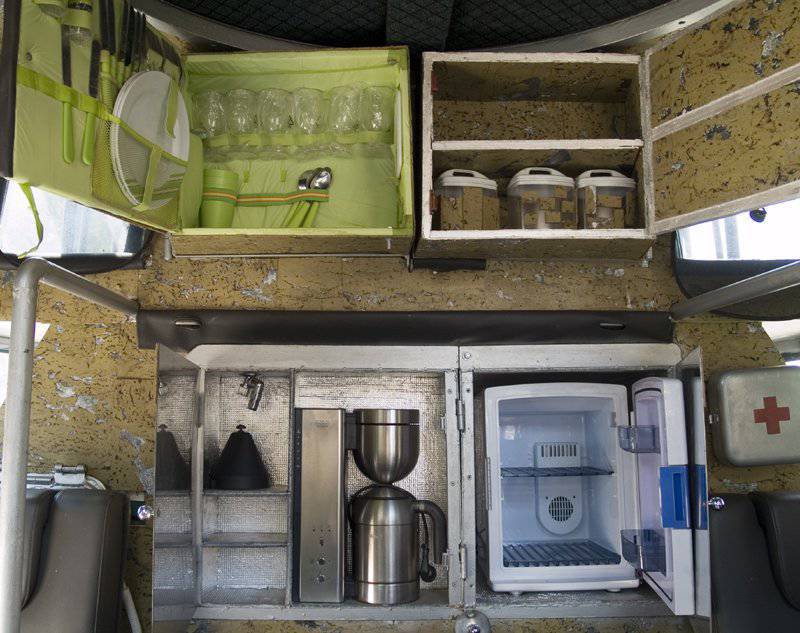
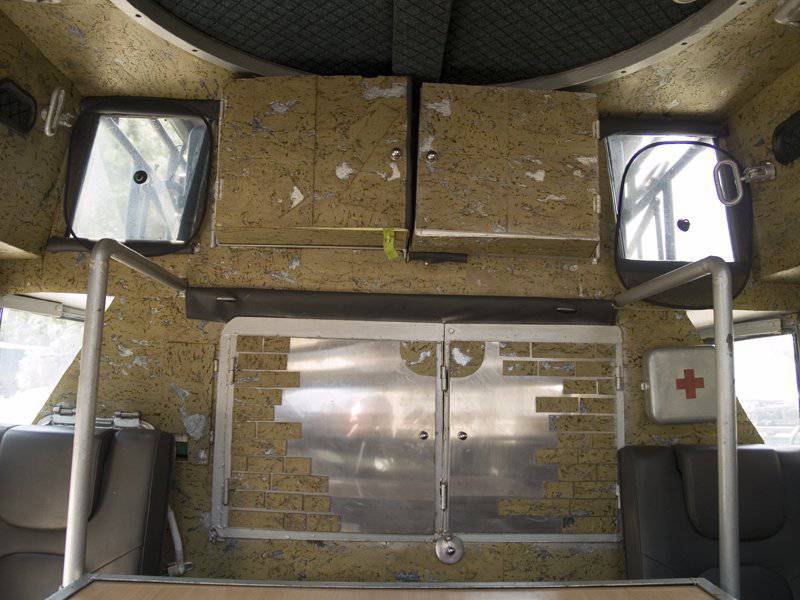
The improved design of the hinges to which the galley containers are attached, makes it easy to remove these containers from the hinges, thus providing quick access from the passenger compartment to the engine compartment. From the cabin side, the opening giving access to the engine compartment has increased by 300%, the design of the galley is easily dismantled in parts by one person (the driver). The created partition with insulating containers is an excellent thermal and vibration insulation between the engine compartment and the interior.
Корпус. Multipurpose expeditionary trunk load up to 1 tons is a one-piece welded structure connected to the body of the machine. On the fasteners of the trunk are laid 4 special sand truck, made of airfield steel plates (when used as bridges to overcome the moats - can withstand the weight of the machine). Sand tracks laid on the trunk, are used as a transport platform, which is installed on a quad or snowmobile.
Each machine has quick-release guides (skis) for mounting a motor boat or a water scooter on them, and fasteners with a shock absorber for an outboard motor. There is a davit with a winch on 3 tons for launching / lifting the vehicle mounted on the trunk. On the model of U.M.K.A. it is folded on the superstructure of the superstructure, along the hull, in a horizontal position. The descent / raising of an additional vehicle located on the trunk can be made in amphibian mode (afloat).
On a trunk lateral folding ladders of various design fasten.
On the model of U.M.K.A. their 2 units, and they are located on each side of the board, are used for access to the trunk and for lifting onto the upper deck / superstructure.
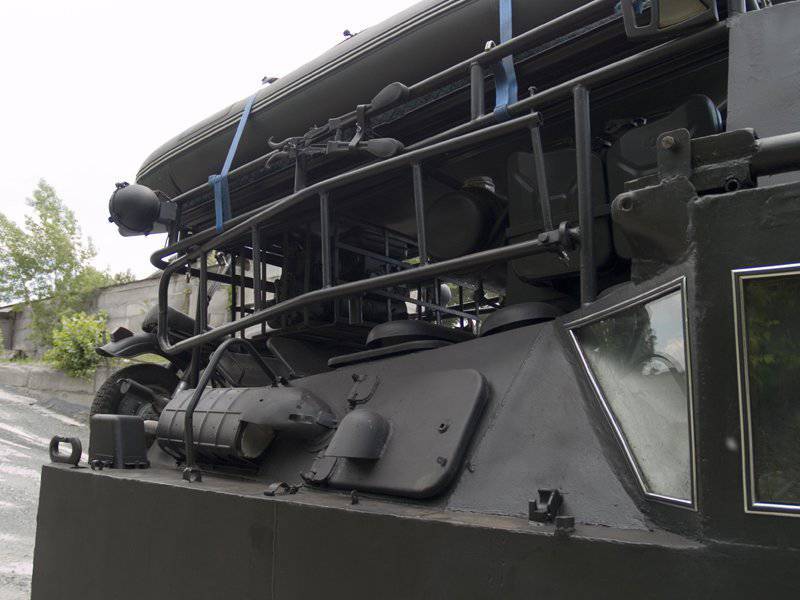
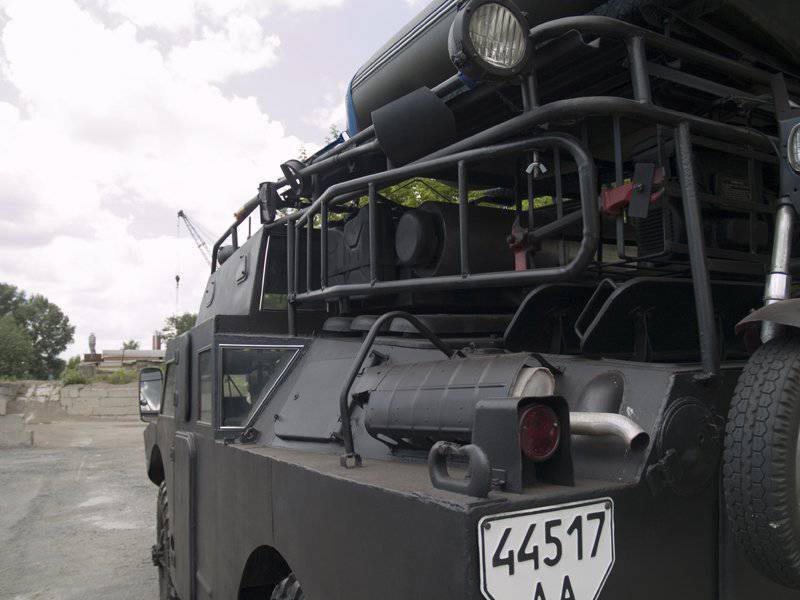
Removable metal baskets for an autonomous power station (3 kW), an autonomous removable diesel heater, as well as jerry cans, camouflage nets, tents, awnings, lifebuoys, anchors, etc are installed on the trunk, in the niches between the send-tracks (transport platform). d. On the sides of the trunk there is a hook mounted tool (Fiskars, Finland), a reel with an additional winch cable 50 m. At the stern of each car there is a mount for an Enduro motorcycle (removed by davit).
By car there are drinking water tanks with output to the saloon, to the galley.
On the model of U.M.K.A. one tank, the volume of 120 liters, it is behind the external trunk-refrigerator for game.
Each machine comes complete with an electric pump for quickly filling tanks and a portable shower. Depending on the goals set before us, we complete the expeditionary trunk with the necessary equipment. Armored doors (BTR-70) and solid armored hatches with BTR-60 are embedded on the sides of the hull, the same hatch is embedded under the roof in the direction of the nose. The locking points of the hatches, hatches and doors were modified in a marine manner: like on submarines.
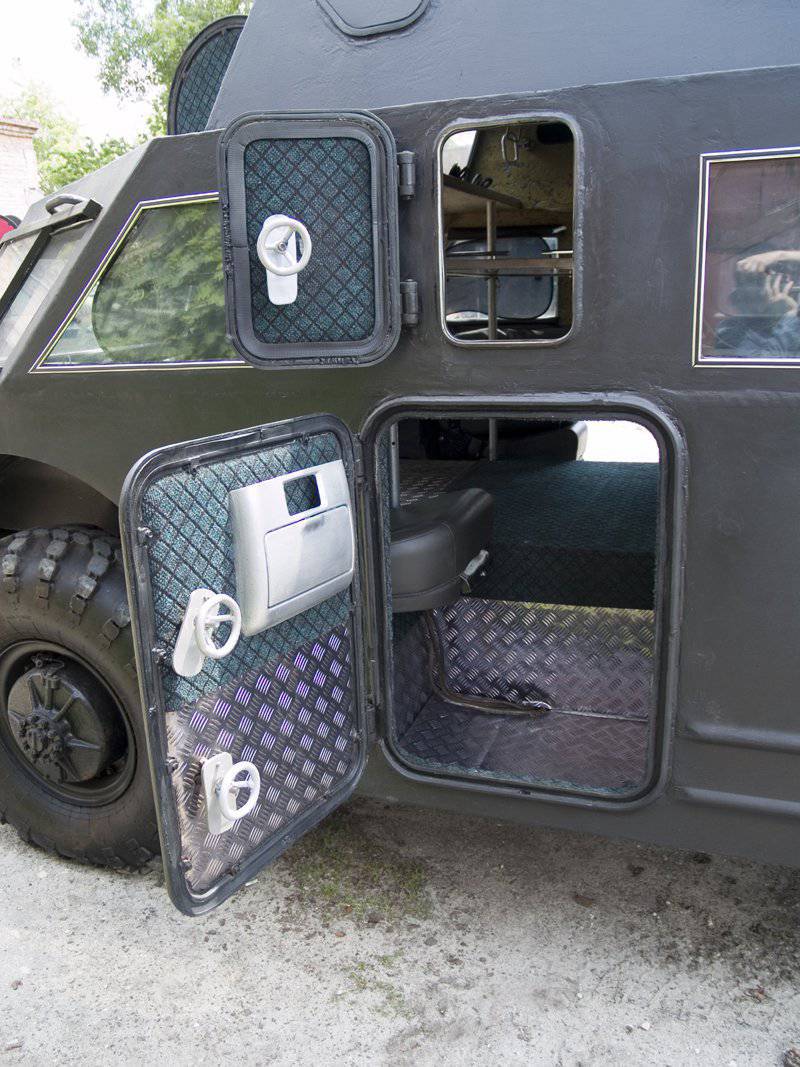
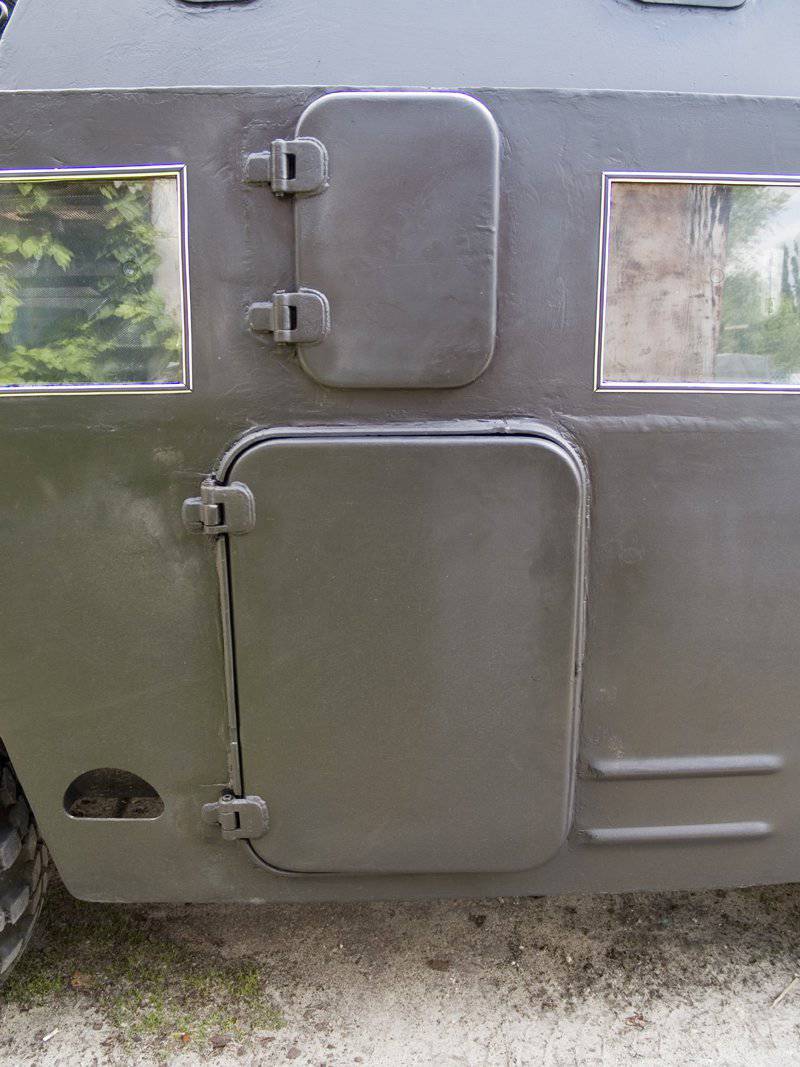
Technical details and photos: Oleg MAKAROV
Read in the following material about the second car of Oleg Makarov: S.O.V.A. - Super Hunting amphibious SUV!
To be continued ...
On the materials of the sites:
http://media.club4x4.ru
http://forum.guns.ru
http://abunda.ru
http://vezdehodlab.ru
http://www.drive2.ru
http://www.btvt.com.ua
http://бомба.com
http://www.borshec.ru
http://auto.newsru.com
http://www.ridus.ru
http://www.cherinfo.ru
http://poligon-mc.com
http://www.hint4.me
http://pinzgauer-rus.ru
http://pinzgauer.spb.ru
- Mikhail Zadunaysky
- http://media.club4x4.ru http://forum.guns.ru http://abunda.ru http://vezdehodlab.ru http://www.drive2.ru http://www.btvt.com.ua http://бомба.com http://www.borshec.ru http://auto.newsru.com http://www.ridus.ru http://www.cherinfo.ru http://poligon-mc.com http://www.hint4.me
Information